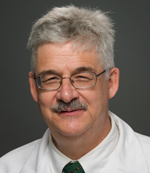
Charles G. Irvin, PhD
Unusual roles come naturally to Charles G. Irvin, PhD, director of the Vermont Lung Center at the University of Vermont.
When the scientist-revered for his work in pulmonary physiology and asthma pathogenesis-was asked to step in as interim chief of the Division of Pulmonary and Critical Care Medicine at Fletcher Allen Health Care, in Burlington, Vt., he simply accepted.
“My clinical colleagues were 100 percent behind the whole thing,” says Dr. Irvin, who filled the role from 1999 to 2000. “And we managed to muddle through it all right and even expanded the number of beds in the ICU during that time.”
That’s because Dr. Irvin isn’t your average PhD.
“Charlie is the most clinically knowledgeable PhD that I have ever met in my entire existence,” says James J. Lee, PhD, who runs a Mayo Clinic laboratory. “He’s ‘Mr. Lung’ in terms of the research community, but he really has a reputation of being that quintessential clinician-scientist.”
At the university, Dr. Irvin is also professor of medicine and molecular physiology and biophysics, vice chairman of research affairs for the Department of Medicine, and assistant dean for faculty for the College of Medicine. As the principal investigator of the American Lung Association Asthma Clinical Research Center Award to Vermont, he is deeply engaged in clinical trials and was the lead investigator on the Effectiveness of Low Dose Theophylline as Add-on Treatment in Asthma (LODO) trial.
An ATS member since 1974, he’s served as chair of the Assembly on Respiratory Structure and Function and on the Board of Directors as well as the editorial boards of the American Journal of Respiratory Cell and Molecular Biology and American Journal of Respiratory and Critical Care Medicine, among many other ATS posts.
His research has been highly collaborative-and highly diverse. He’s focused on basic studies, animal models, and clinical trials. He’s become an authority on animal models of asthma pathogenesis. For years, Dr. Irvin has helped Dr. Lee and others interpret lung-function tests in animal models.
“He’s created the fundamental mouse models of asthma,” Dr. Lee says. “And as far as making these types of lung function measurements, there is nobody’s word out there that’s higher than Charlie’s. If there’s controversy, somebody’s going to invariably ask Charlie his opinion.”
Dr. Lee’s lab studies eosinophils, the pro-inflammatory cell infiltrates that go into the lungs of asthmatics and COPD patients, by genetically engineering mice to replicate patient conditions. “With Charlie’s help we can ask questions about lung function and how efficient the lungs are operating and what are the consequences of all the tinkering that we’re doing,” Dr. Lee says.
At the University of Vermont, Dr. Irvin has been collaborating with Yvonne Janssen-Heininger, PhD, to study how the epithelium orchestrates the response to inhaled allergen and other insults in the lung, and examine Nuclear Factor kappa B (NF-kB) captivation in the epithelia.
“Charlie is absolutely instrumental in helping us design some of the studies that we’re doing and interpreting the data,” Dr. Janssen-Heininger says. “In terms of understanding changes in respiratory mechanics in mice, there are very few people who know how to do that well.”
To know Dr. Irvin is to know his mentors.
Dr. Irvin earned his PhD in physiology in 1978 under Jerome “Jerry” A. Dempsey, PhD, who researches the regulation of breathing in various physiologic states in un-anesthetized humans and animals at the John Rankin Laboratory of Pulmonary Medicine.
Dr. Irvin then earned an NIH–NRSA grant to take his post doctoral fellow under the late Peter T. Macklem, MD, at Meakins-Christie Laboratory at McGill. Dr. Macklem’s work constitutes the scientific basis for the ongoing campaign against smoking.
Recruited by Reuben M. Cherniack, MD, Dr. Irvin was hired in 1980 as assistant professor at the University of Colorado Health Sciences Center in Denver and as the associate director of the Pulmonary Physiology Unit at the National Jewish Center for Immunology and Respiratory Medicine.
Over a decade, he rose up the ranks to become a full professor and, interestingly, the medical director of the Pulmonary Physiology Unit at National Jewish. “The world was different in 1980-rules and regulations weren’t quite as crazy as they are now,” Dr. Irvin says. “But between Dempsey, Macklem, and Cherniack, I had some of the best mentors in North America. So it made sense, and we performed a critical diagnostic service for the physicians and especially for the patients with the worst of the worst lung disease.”
In 1998, he seized the opportunity to move to Vermont. “The Vermont Lung Center was a bit dormant,” Dr. Janssen-Heininger says. “Some of our previous leadership had moved on. Though the research community was active, it had lost some its vibrancy.
“When Charlie came, things changed almost overnight.”
Dr. Irvin, who’s secured millions in research funding during his career, wrote the National Center for Research Resources Center of Biomedical Research Excellence grant, one of only two NIH COBRE grants on Lung Disease.
“As a result, the Vermont Lung Center was reborn,” Dr. Janssen-Heininger says.
At the Lung Center, Dr. Irvin has also been the building careers of junior faculty. Though a full professor herself, Dr. Janssen-Heininger calls him the ultimate mentor. “He’s one of these unique people who really cares about the education and professional development of his clinical scientists, but also of his basic research scientists.”
To Dr. Irvin, being a mentor might come as the most natural role. “That’s one of the most gratifying and important things you get to do.”

